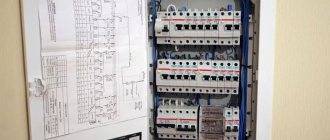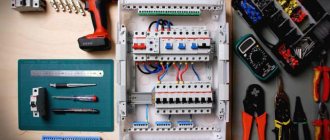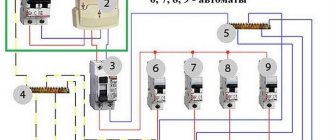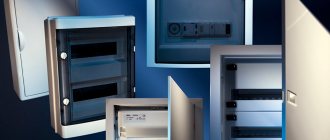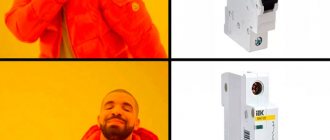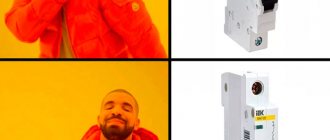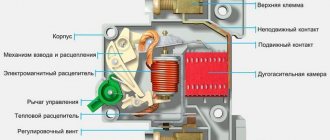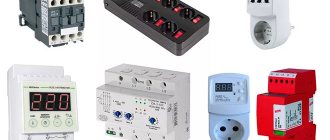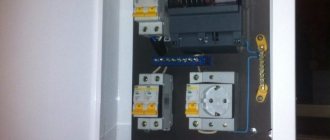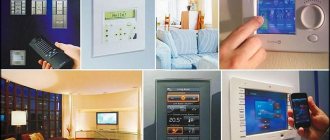The process of assembling a switchboard requires special skills and knowledge. The service life of the devices and the reliability of the home’s power supply system depend on the correctness of the chosen scheme and the distribution of consumers. If in old houses with a minimum number of electrical appliances two or three automatic machines were enough, then in modern housing it is necessary to take care of the reliability of the network. Below are basic recommendations on how to assemble a switchboard for an apartment, what circuits and devices should be used, as well as recommendations for eliminating errors.
What is an electrical panel and what is it for?
An electrical panel is a structure consisting of complex modular devices designed to control the power supply network. The main purposes include:
- receiving incoming voltage from the general power supply network of the house;
- analysis of incoming energy parameters and shutdown of the internal network at critical values;
- distribution of consumers into groups by zones, power, purpose;
- direct connection of powerful consumers such as hobs, boiler, washing machines, air conditioning, etc.;
- protection of wiring and household appliances from short circuits and other critical situations;
- ensuring complete safety during operation of the power supply network.
As a rule, they are mounted together with an electricity meter for greater convenience. In new housing stock, where metering devices are located in the corridor, shields are installed at the front door.
Important! It is necessary to provide free access to the panel in order to turn off the machines if necessary.
Principles of distribution of electricity by groups
Distribution boards, in which several machines are used for the entire apartment, are a thing of the past. The need for a large number of modular devices is explained by convenience and increased safety. If an outlet breaks down in one of the rooms, you can turn off one circuit breaker, and the rest of the network will continue to operate as normal. The basic rules for assigning groups are described below.
- Powerful consumers . All devices with a power of more than 2 kW are connected separately or combined into small groups. For each of them, a separate line is drawn with an individual circuit breaker. As a rule, the cable cross-section and machine rating are chosen with a small margin. For most cases, a copper cable VVGng or NYM with a cross-section of 2.5 mm2, as well as a 16A automatic, is suitable.
- Heavy-duty devices require separate lines. Such devices may include instantaneous water heaters from 5.5 kW and hobs, the power of which starts from 6.5 to 9.5 kW. To connect them, use a cable with a cross-section of 4 or 6 mm2, as well as 25A and 32A circuit breakers.
- Outlet groups are combined by room, and several groups are also created for one large room. The common line runs from the panel to the junction box, where the cable branches. A VVGng or NYM cable with a cross section of 2.5 mm2 and a 16A circuit breaker are sufficient.
- Lighting is distributed among the rooms . For example, different groups for the bathroom, bedroom, balcony. Lines with a 1.5 mm2 wire are protected by 10A circuit breakers.
Reference! The rating of the machine directly depends on the cross-section of the cable, as well as the power of the consumers.
Electrical panel assembly tool
Tools and devices that you will need to use in order to assemble the shield with your own hands efficiently and competently:
- ⚡
screwdrivers (phillips+slotted) - ⚡
pliers, side cutters, cable cutters, platypuses - ⚡
press pliers for tips - ⚡
insulation stripper - ⚡
marker - ⚡
knife - ⚡
wire PV 3-1.5 and PV 3-10 (for jumpers) - ⚡
comb shank - ⚡
various consumables for electrical wiring (lugs, screws, cable ties) - ⚡
a diagram with a list of groups for assembling the shield
It is advisable at the preliminary stage to insert the cables into the shield not haphazardly, but in order, according to the numbered groups.
Let's say from the first to the tenth groups, from left to right. To ensure that the bundle of cables does not interfere with the assembly process, make an improvised hook on the side of the shield from scrap materials, and bend the cables and secure them to this device.
Let's get straight to work.
Requirements for distribution panels
There are special requirements for electrical equipment, since it is responsible for the safe operation of household appliances. The following must be required:
- Availability of a technical passport with a description of consumers and rated current.
- Developed connection diagram.
- Marking of wires with the designation of line devices.
- Grounding the shield and all connected devices.
- If the shield is metal, the structure and doors must be grounded, and the housing coating must be dielectric.
- The presence of free terminals on the neutral and ground wire buses.
- The shield is made of non-flammable material.
Reference! All shields must comply with the rules of GOST 51778-2001 and PUE.
Features of connecting power panels
Connection to the power panel , as well as connection inside the cabinet of switches, RCDs, limiters and other elements of the control panel can be carried out using various installation and connecting wires:
- Surfactant Installation wire with aluminum conductor core with PVC insulation. The wire is available in single- and multi-wire versions, flexibility class 1, 2.
- PVS. Household wire for connecting household appliances and extension cords in PVC insulation and PVC sheath with copper stranded conductors of class 5 flexibility.
- PuV. Installation wire with copper core and PVC insulation, flexibility class 1, 2.
- PuGV. PVC-insulated installation wire is used to connect stationary units and devices, flexibility class 5.
- SHVVP. The household cord with PVC insulation and PVC sheath is designed for connecting lamps, ARBs and indoor floor lamps.
Packages of wires are pulled together into bundles with clamps, and the contacts are stripped and crimped with lugs. The length of the conductors is selected so as to prevent them from sagging. offers to buy cable products from the largest manufacturers. All listed wires are available in stock and can be ordered in any quantity.
All products undergo official registration and are sent with a package of necessary documents.
A large warehouse with an area of more than 2,500 m2, as well as equipment with a crane and forklifts, allows the company to generate large orders from several clients at once. Therefore, your order will be delivered promptly and on time. back
Drawing up a diagram
Modern power supply systems involve the use of a three-wire cable, where one wire is a phase, and the rest are ground and zero. Given the growing power of devices, it is also necessary to divide them into groups, which allows to increase the service life of the wiring. Guided by these principles, we proceed to drawing up a diagram of the shield.
Advice! It is better to entrust the design of the panel and electrical wiring of the apartment to a professional so as not to miss important details. Otherwise, you will have to redo the repair.
It is mandatory to install a protection device on the input cable, which will protect the internal network from overvoltage. Then they install a voltage relay to control surges in the network, after which they proceed to the installation of groups and individual lines. It is worth noting that for powerful devices, in addition to switches, additional RCDs or differential circuit breakers are used. Such organization of the home electrical network is not only safe, but also convenient. If necessary, you can turn off the machine and turn off the washing machine. You can also turn off the RCD and de-energize all consumers included in the global group.
Electrical Panel Components
The distribution board consists of many devices. For reliable operation of the home electrical network and protection of household appliances, it is necessary to use circuit breakers, RCDs and differential circuit breakers, voltage control relays, buses and much more.
Circuit breakers
Devices for automatic protection of the line that is connected to them. They interrupt the power supply if the current in the line is significantly higher than the rated value. Protection against cable heating is also provided.
RCD and diffautomatic devices
The residual current device (RCD) switches off the load if leakage currents appear. First of all, people can suffer from them. The leak also negatively affects the wiring, causing the wires to heat up and catch fire.
Differential circuit breaker - protects against short circuits, overloads, and current leaks. It is often used instead of a combination of a pair of RCDs and a conventional machine. The main advantage is short circuit protection.
Voltage control relay
The device is used to measure the incoming voltage and maintain a given value. In case of sudden surges in the network, the device turns off the power supply. The electrical circuit is closed only after the indicator and time delay have been restored. The main purpose is to protect electrical appliances from power surges.
Grounding and grounding buses
Busbars for grounding and zero are used for ease of installation, as well as compliance of the shield with all the rules of GOST and PUE. The number of DIN rails depends on the number of machines and other modules, so it is necessary to draw up an installation diagram in advance.
Comb tire
It is used instead of cable jumpers, which were previously made by electricians themselves. The comb looks like a solid plate with protruding teeth and is designed to connect machines standing in the same row.
Other equipment
As additional equipment in the distribution panel, modular contactors, load switches, DIN rail sockets, timers and much more are used. Other devices increase the convenience of managing the power supply network.
Purpose of power shields
A power distribution board is a necessary element in power and lighting installations in buildings for any purpose. In power supply, this device plays a central distribution role. It helps to correctly distribute and protect the electrical networks of objects with different numbers of consumers.
The panel contains protective, indicating and switching equipment. Due to its design features, the switchboard performs several functions:
- Provides electrical appliances with the necessary voltage (up to 380 V).
- Protects against overload and short circuit currents (if there is an RCD unit or differential circuit breakers).
- Divides the power circuit into separate groups, thereby protecting against phase imbalance.
- Allows you to disconnect the lines of group circuits.
How to calculate the number of places in an electrical panel?
All equipment for the switchboard is standardized and installed on a special DIN rail. The unit of measurement for space is considered to be a “module” with a width of 17.5 mm. All panels are sold depending on the amount of space: for 8, 12, 24, 36 modules.
Reference! To calculate the number of seats, it is necessary to take into account all devices, including RCDs, automatic machines, voltage relays, and differential automatic devices.
Circuit breakers have a standard width of 17.5 mm. The remaining devices have the following characteristics:
- two-pole circuit breaker - 2 modules and 35 mm;
- three-pole circuit breaker - 3 modules, 52.5 mm;
- single-phase RCD - 2 modules and 35 mm;
- three-phase RCD - 4 modules and 70 mm;
- diffautomatic - 2 modules and 35 mm;
- voltage relay - 3 modules, 52.5 mm;
- DIN rail socket - 3 modules, 52.5 mm;
- terminals for DIN rail - 1 module 17.5 mm.
Electrical panel assembly
When the panel diagram has been created and the electrical wires have been laid around the apartment, we proceed to assembling the panel. If desired, you can order a prepared shield, which all that remains is to install and connect the input cable.
Advice ! Indoor renovation is a messy process, so it is recommended to assemble the panel in another place, and then install the finished equipment in place.
Marking and installing DIN rails
First, markings are made of where the modules will be located and how long the slats are needed. During the fitting process, they also take into account the distance between the rows, if there are several of them, as well as the distance between the zero and ground buses. When the marking is ready, the slats are installed in the required places.
Reference! Most panels are standardized, so the placement of the slats is limited by the manufacturers.
Installation and switching of modular devices
At the stage of installation of modular devices, automatic machines and additional devices are installed on a DIN rail. They are also connected to each other. First of all, they install an input circuit breaker, then voltage relays, RCDs and differential circuit breakers, which are located in front of conventional switches.
Advice! Install the modules closer to the center, leaving space on the sides for neat cable management.
Organization of cable entry into the electrical panel
At the stage of cable entry, it is necessary to make holes in the shield. As a rule, all insertion points are provided by the manufacturer, so it is enough to squeeze out the plastic. On one side, a general network cable is installed, which is connected to the input circuit breaker, and on the other, internal network wires.
Selection of machines for a house or apartment panel
There are three types of devices used in an electrical panel:
- Machine. Turns the power off and on manually, and also triggers (breaks the circuit) in the event of a short circuit in the circuit.
- RCD (residual current device). It controls the leakage current that occurs when the insulation breaks down or if someone touches the wires. If one of these situations occurs, the circuit is broken.
- Diff. automatic (differential automatic). This is a device that combines two in one housing: it monitors both the presence of short circuit and leakage current.
Differential automatic devices are usually installed instead of a combination - RCD + automatic. This saves space in the panel - it requires one less module. Sometimes this is important: for example, you need to turn on another power line, but there is no space for installation, just like there is no free machine.
A differential automatic machine is installed instead of a combination of an automatic machine and an RCD
In general, two devices are often installed. Firstly, it is cheaper (differential circuit breakers are more expensive), secondly, when one of the protective devices trips, you know exactly what happened and what to look for: a short circuit (if the circuit breaker was turned off) or a leak and possible overcurrent (triggered RCD). You will not find this out when the automatic machine is triggered. Unless you install a special model that has a flag indicating what malfunction the device was triggered by.
Automatic circuit breakers
Circuit breakers are selected according to the current required for consumers of this group. It is calculated simply. Add up the maximum power of all simultaneously connected devices in the group, divide by the network voltage - 220 V, and get the required current power. Take the device rating a little higher, otherwise when all loads are turned on, it will turn off due to overload.
For example, adding up the power of all devices in a group, we got a total value of 6.5 kW (6500 W). Divide by 220 V, we get 6500 W / 220 V = 29.54 A.
What numbers on the body mean what?
The current ratings of the circuit breakers can be as follows: (in A) 6, 10, 16, 20, 25, 32, 40, 50, 63. The closest larger one to the given value is 32 A. This is what we are looking for.
Types and types of RCD
There are two types of RCDs: electronic and electronic-mechanical . The difference in price for a device with the same parameters is large - electronic-mechanical ones are more expensive. But you need to purchase them for a shield in your house or apartment. There is only one reason: they are more reliable, since they operate regardless of the presence of power, while electronic ones require power to operate.
For example, the situation is this: you are repairing wiring, for example, a socket, and for this purpose you have de-energized the network - turned off the input circuit breaker. In the process, the insulation was damaged somewhere. If an electro-mechanical RCD is installed, it will operate even in the absence of power. You will realize that you did something wrong and will look for the reason. Electronic equipment is inoperative without power, and if you turn on a network with damaged insulation, you may have problems.
To understand which device is in front of you, it is enough to have a small battery and a couple of wires on hand. Battery power is supplied to any pair of RCD contacts. The electro-mechanical one will work, but the electronic one will not. More details about this in the video.
Next, RCDs are distinguished by the type of current to changes in which they respond:
- type AC - alternating sinusoidal current;
- type A - alternating current + pulsating direct current;
- type B - alternating + pulsating direct + rectified current.
It turns out that type B provides the most complete protection , but these devices are very expensive. For a house or apartment panel, type A is quite sufficient , but not AC, which are mostly sold because they are cheaper.
In addition to the type of RCD, it is selected by current. Moreover, according to two parameters: nominal and leakage . A nominal one is one that can pass through the contacts without destroying (melting) them. The rated current of the RCD is taken one step higher than the rated current of the machine installed in pair with it. If a machine is needed for 25 A, then take an RCD for 40 A.
In terms of leakage current, everything is even simpler: only two ratings are installed in electrical distribution boards for apartments and houses - 10 mA and 30 mA. 10 mA is placed on a line with one device, for example, a gas boiler, washing machine, etc. as well as in rooms where a high degree of protection is necessary: in a children's room or bathroom. Accordingly, a 30 milliamp RCD is installed in lines that include several consumers (devices) - on sockets in the kitchen and rooms. Such protection is rarely installed on lighting lines: there is no need, except for street lighting or in a garage.
What numbers on the body mean what?
RCDs also have different response delay times. They are of two types:
- S - selective - triggers after a certain time after the appearance of the leakage current (quite a long period of time). They are usually placed at the entrance. Then, if an emergency occurs, the device on the damaged line is first turned off. If the leakage current remains, then the “senior” selective RCD will operate - usually this is the one located at the input.
- J - also triggers with a delay (protection against random currents), but with a much shorter delay. This type of RCD is placed in groups.
Differential circuit breakers come in the same types as RCDs and are selected in the same way. Only when determining power by current do you immediately consider the load and determine the rating.
For a few explanations on installing a built-in cabinet for a panel and the connection procedure, see the video from a practitioner and generalist.
One important detail that is important for safety. There is a “test” button on the RCD or differential circuit breaker. When it is pressed, a leakage current is artificially created and the device must operate - the switch goes to the “off” position and the line is de-energized. This is how functionality is checked. This must be done at least once a month to be sure of the reliability of the protection. Check all the RCDs in the circuit one by one. It is important.
This is probably all the information you need to assemble an electrical panel with your own hands. You may also need to learn more about how to divide the workload into groups; read about that here.
Basic installation mistakes
- A flexible multi-core cable without sleeves at the ends is a weak point in electricity. Over time, the quality of the contact weakens, the connection begins to heat up and cause problems.
- The cable insulation gets into the terminal, and at times of high loads it heats up and melts.
- Wires of different cross-sections per machine - this inevitably leads to poor contact, overheating of the wire and even a fire.
- Soldering the ends is an old and not reliable enough way to connect wires. Only suitable ferrules are used for connection.
Be sure to crimp stranded wire or use rigid solid cable.
Causes of wear
Any equipment tends to wear out. Wear of the shield occurs for mechanical, electrical or moral reasons and depends on the quality of the material from which it is made. Mechanical wear may occur due to housing failure. Electrical is associated with deterioration of insulation, burnt wires or fuses. Obsolescence occurs due to the obsolescence of the shield, its non-compliance with modern requirements, and also if it has an unpresentable appearance.
The wiring may be in disrepair, and if there has been a fire, then the shield is most likely damaged - it has melted and has traces of burning.
If repairs have not been carried out at the entrance for a long time, especially electrical equipment, floor panels can become sources of increased danger. Even minor problems - flickering lights, lights out, frequent operation of circuit breakers - often become causes of serious problems.
In some cases, a complete replacement of the shield is not required; only some of its parts may be faulty. In this case, it is enough to replace, for example, the door. Manufacturers offer separate components for electrical panels (if you cannot find doors from the manufacturer, you can find private craftsmen who will make custom doors). There are transparent or regular plastic parts to match the base or a contrasting color to replace electrical panel doors.
